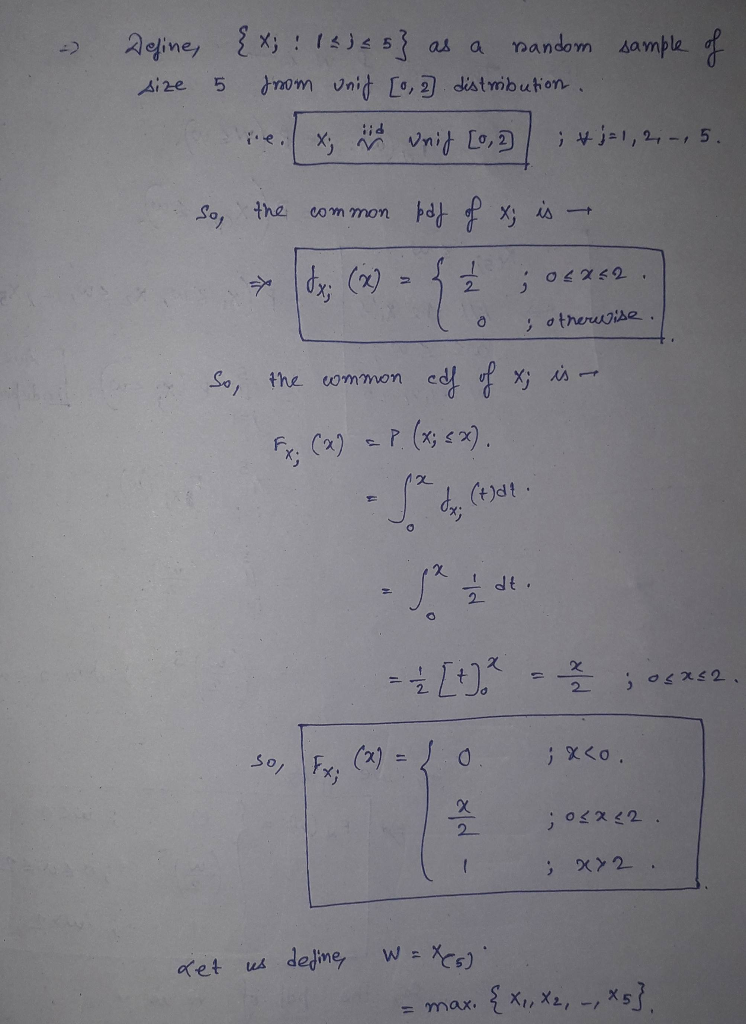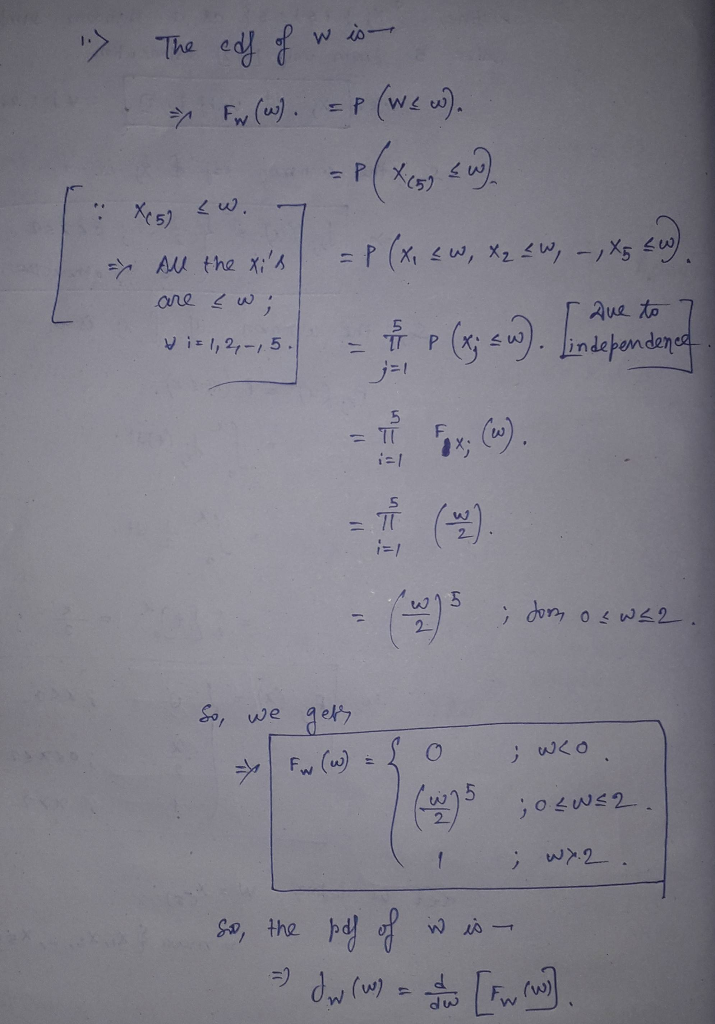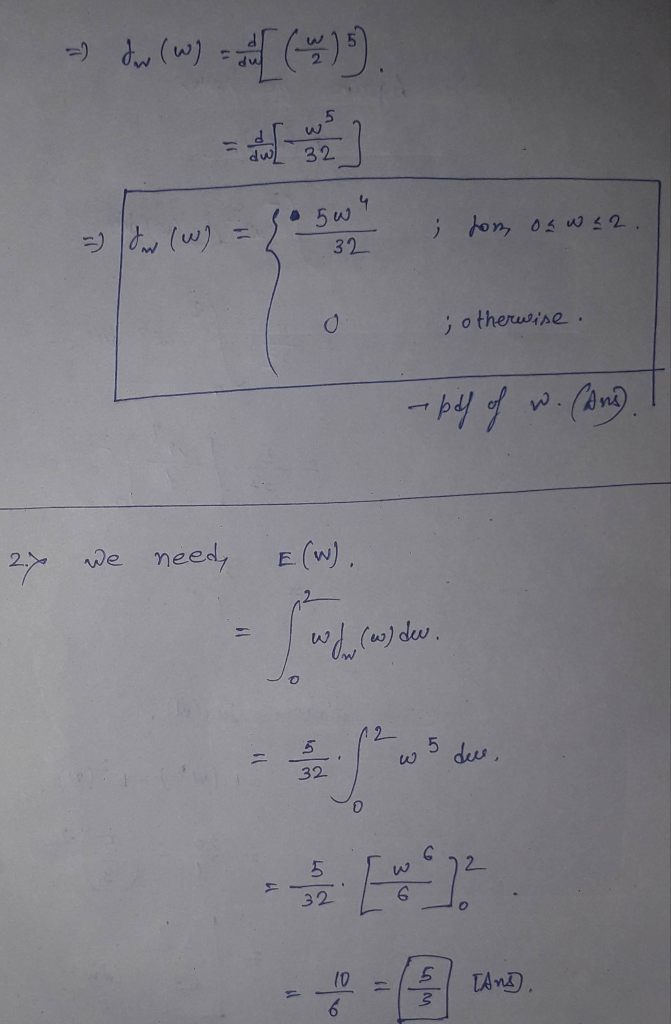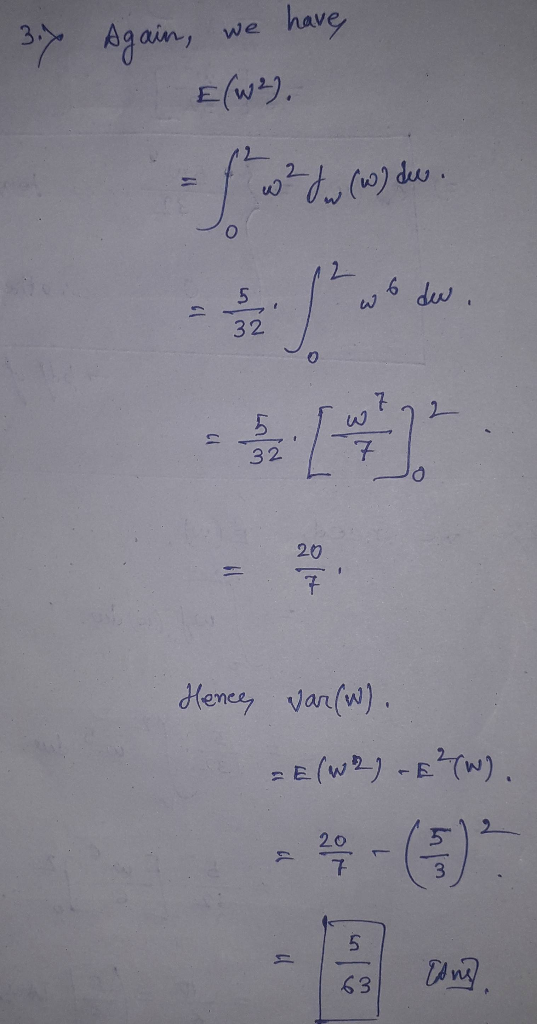Question
In: Math
Assume that a sample {Xj : 1 ≤ j ≤ 5} of size 5 is drawn...
Assume that a sample {Xj : 1 ≤ j ≤ 5} of size 5 is drawn from Unif(0, 2). Consider the maximal value, W = X(5).
1. Derive density function of X(5)
2. Find expected value of X(5)
3. Determine variance of X(5)
Solutions
Related Solutions
Assume that a sample X = {Xj : 1 ≤ j ≤ 10} of size n...
Assume that a sample X = {Xj : 1 ≤ j ≤ 10} of size n = 10 was
drawn from the uniform distribution on the interval (0 < x <
4). Let X[k] denote the k th order statistic based on this sample.
1. Evaluate expected value of X[5] 2. Derive conditional
expectation of X[5], given that X[10] = 3.
. Let xj , j = 1, . . . n be n distinct values. Let...
. Let xj , j = 1, . . . n be n distinct values. Let yj be any n
values. Let p(x) = c1 + c2x + c3x 2 + · · · + cn x ^n−1 be the
unique polynomial that interpolates the data (xj , yj ), j = 1, . .
. , n (Vandermonde approach).
(a) Remember that (xj , yj ), j = 1, . . . , n are given. Derive
the n...
A sample size 5 will be drawn from a normal population with mean 60 and standard...
A sample size 5 will be drawn from a normal population with mean
60 and standard deviation 12.
a. Is it appropriate to use the normal distribution to find
probability for ?̅? Explain why?
b. If appropriate find the probability that ?̅will be between 50
and 70.
c. If appropriate find the 80th percentile of ?̅?
Given the likelihood of θ with respect to sample D p(D|θ) = Q j p(xj |θ),...
Given the likelihood of θ with respect to sample D p(D|θ) = Q j
p(xj |θ), where D = {x1, · · · , xn} is identically and
independently distributed (i.i.d) sample points. Briefly describe
how you would find the maximum likelihood estimation and the
Bayesian estimation of θ.
A simple random sample of size n is drawn. The sample mean is found to be...
A simple random sample of size n is drawn. The sample mean is
found to be 17.6, and the sample standard deviation, s, is found
to be 4.7.
A). Construct a 95% confidence interval about if the sample
size, n, is 51.
A simple random sample of size n is drawn. The sample mean is found to be...
A simple random sample of size n is drawn. The sample mean is
found to be 17.6, and the sample standard deviation, s, is found
to be 4.7.
Construct a 99% confidence interval about if the sample size,
n, is 34.
A simple random sample of size n is drawn. The sample mean, x, is found to...
A simple random sample of size n is drawn. The sample mean, x,
is found to be 18.5, and the sample standard deviation, s, is
found to be 4.6.
(a) Construct a 95% confidence interval about μ if the sample
size, n, is 34.
Lower bound: ___
Upper bound: ___
(Use ascending order. Round to two decimal places as
needed.)
(b) Construct a 95% confidence interval about μ if the sample
size, n, is 61.
Lower bound: ___
Upper bound:...
A simple random sample of size n is drawn. The sample mean, x, is found to...
A simple random sample of size n is drawn. The sample
mean, x, is found to be 35.1, and the sample standard deviation, s,
is found to be 8.7
a) Construct a 90% confidence interval for μ if the
sample size, n, is 100.
b) Construct a 90% confidence interval for μ if the
sample size, n, is 40. How does decreasing the sample size affect
the margin of error, E?
c) Construct a 96% confidence interval for μ if...
A simple random sample of size n is drawn. The sample mean, x , is found...
A simple random sample of size n is drawn. The sample mean, x
, is found to be 18.5 , and the sample standard deviation, s, is
found to be 4.3.
(a) Construct a 95% confidence interval about mean if the
sample size, n, is 35.
(b) Construct a 95% confidence interval about mean if the
sample size, n, is 71. How does increasing the sample size affect
the margin of error, E?
(c) Construct a 99% confidence interval about...
A simple random sample of size n is drawn. The sample mean, x is found to...
A simple random sample of size n is drawn. The sample mean, x
is found to be 19.3 and the sample standard deviation, s, is found
to be 4.7
a. Construct a 95% confidence interval about mu if the sample
size, n, is 35
ADVERTISEMENT
ADVERTISEMENT
Latest Questions
- A Light of wavelength 650 nm falls on two slits and produces an interference pattern in...
- Will Magnesium spontaneously reduce Copper ion (Cu+2) to Copper (Cu)? Explain. What is the Edegree? Mg(s)...
- How a cell can extract 38 molecules of ATP (net) from one molecule of glucose? Explain...
- Business Ethics: Do you think these codes are effective?
- Describe why the mining of uranium are often pollutes the local environment?
- Explain why vacuum pumps are used with rotary evaporators. What is the advantage of using a...
- What are three incidences in which animations or transitions may be appropriate in a business presentation...
ADVERTISEMENT




 milcah answered 2 months ago
milcah answered 2 months ago